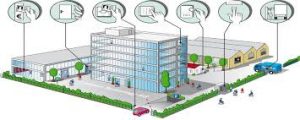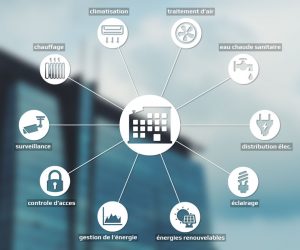Building Management System (BMS) is a computer system typically installed in large buildings or industrial facilities to supervise all equipment installed there.
GTB is moving towards active management of the building, via the building automation.
Goal
This is to allow the manager to have a global view of the operation and automation of a building or industrial facility.
The data collected are of various types:
- alarms (failure, abnormal stop, measurement exceeding a threshold …);
- states (operation of equipment, position, return of command …);
- measurements (temperature, operating time, number of failures …).
Supervised equipment can be among others:
- power supply (TGBT, Divisional Tables); emergency power supply (generators, batteries)
- lighting;
- vertical circulation;
- heating, ventilation and air conditioning (HVAC);
- plumbing (lift pumps, tanks …);
- access control;
- video surveillance;
- fire devices (alarms, extinguishing).
Building Management Systems (BMS) oversee and control services such as heating, ventilation and air conditioning, ensuring that they operate in the most efficient and economical way. This is possible by optimizing the balance between environmental conditions, energy uses and operational needs. Even the smallest system can save you money.
Building Technical Management (BMS) is the set of information processing systems coming from the same site. GTB treats the same elements as home automation on a larger scale.
- Comfort management
- Fire safety
- Access control
- Intrusion detection
- Video surveillance
- Energy management
- Electrical management
- Smart Building
Why should you use a smart system ?
To optimize the operation of technical installations, by automating certain procedures. To regulate energy calls to guarantee efficiency and comfort.
 Optimize your building
Optimize your building
Pricing management will reduce utility bills. The hourly programming of the lighting and heating installations will save energy and contribute to the protection of the environment.
Piloting and monitoring of installations
The control of the various actuators by the system allows the management of start and stop sequences for optimal comfort while avoiding waste. By storing records of temperature, hygrometry, operating time, … the facilities keep the event memory and automatically provide useful data to the quality management systems (temperature cycles for heat treatments for example, fouling of the filters for the respect of the quality of the air).
Technological evolution: a controller instead of a regulator
 The evolution and the fall of the prices of the electronic components, the disappearance of certain technologies made the digital system more powerful than the conventional regulator. Ventilation, heating and air conditioning need intelligence to facilitate the management and maintenance of facilities. A heating circuit will need only a simple regulation that will maintain a temperature according to a setpoint, while a set of technical equipment will need a system of centralized controls.
The evolution and the fall of the prices of the electronic components, the disappearance of certain technologies made the digital system more powerful than the conventional regulator. Ventilation, heating and air conditioning need intelligence to facilitate the management and maintenance of facilities. A heating circuit will need only a simple regulation that will maintain a temperature according to a setpoint, while a set of technical equipment will need a system of centralized controls.
At the beginning of the evolution of the GTB, it was question of intelligent products: It was the customer who adapted his needs to the products from where long and expensive trainings at the manufacturer.
Today, the customer wants a simple answer to his needs:
- Flexibility to answer
- Integrator of several products
- Open minded to understand, willingness to provide a global service and not absolutely sell as much as possible.
Either the need for a neutral look, independent of the manufacturer to meet this demand. Indeed, in Europe, the majority of regulation and BMS systems are now provided by integrators.
Advantages of the BMS
The interests of BMSare numerous, but above all it allows optimum management of the different installations, a reduction of maintenance costs and a faster detection of breakdowns.
To reduce energy consumption, building management systems are now systematically installed on all new buildings. Optimization of technical equipment and energy savings are thus expected.
 Concentrating all the technical information, BMSis the intelligence of buildings. This system is based on a computer station equipped with supervision software, sensors, PLCs and actuators. Local processing units (UTLs) are responsible for concentrating and digitizing information from the interface terminals of the control / command equipment irrespective of the types of signals therefrom. By interpreting the collected data, the management center then relays the control commands to the different equipment via the actuators (valves, shutters, etc.). Management is done almost in real time and must best meet the needs of the site. The recording of data also facilitates the establishment of historical records, balance sheets, and analyzes.
Concentrating all the technical information, BMSis the intelligence of buildings. This system is based on a computer station equipped with supervision software, sensors, PLCs and actuators. Local processing units (UTLs) are responsible for concentrating and digitizing information from the interface terminals of the control / command equipment irrespective of the types of signals therefrom. By interpreting the collected data, the management center then relays the control commands to the different equipment via the actuators (valves, shutters, etc.). Management is done almost in real time and must best meet the needs of the site. The recording of data also facilitates the establishment of historical records, balance sheets, and analyzes.
.
